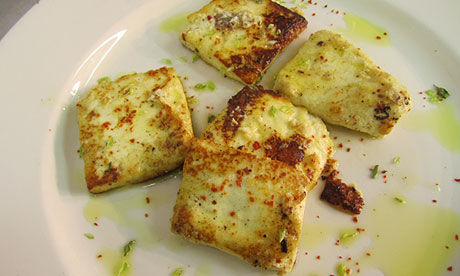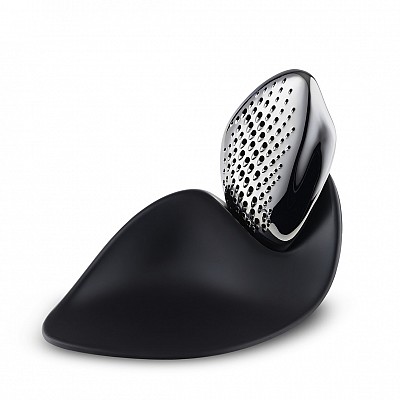Interesting thing I read today and thought it would be nice to share with you... especially if you have kids and want to spend sometime doing some cooking with them. Claire Thomson is a chef who writes a monthly recipe column, Cooking for kids in the Guardian.
Making cheese is easier than you may think and this recipe should entertain your kids too. You can brine the halloumi and keep it for another day, or fry it when it's fresh
 Making cheese with children is easy and loads of fun, striking a brilliant balance between a kind of whizz-bang chemistry and gentle alchemy.
It is a mesmerising sight when a sizable quantity of milk solidifies with just a few teaspoons of rennet (I've always used a vegetarian rennet when making this cheese, which gives consistent results). I have made this fresh cheese many times over, and my favourite attempts have always been with children, enjoying their sense of bewilderment as the enormous saucepan of milk begins to coagulate and take form.
Children will enjoy helping to make the halloumi.
I first made halloumi with kids when I ran a cookery session with around 20 three- and four-year-olds (a notoriously fussy food age). Each child had a go at cutting the curds and scooping them from the whey, then we fried off slices and served them hot with olive oil and lemon. Not one child refused a taste.
Making it again with my two kids (six and three) was an instant hit. The method is simple and can be split into easy timeslots so the children don't need to concentrate for too long. Hot liquids do not really pose a problem until the cheese is made and needs poaching, which is down to you, the adult, to take care of.
You'll need quite a bit of milk in this recipe, and while the yield of cheese is more than enough to feed six people a good lunch, you do get a lot of whey left over after making the cheese. This surplus liquid can be salted and used as a brine should you want to store your cheese for longer than three or four days (and in doing so make it more like the salty, squeaky shop-bought halloumi) or you can use it in any bread-making recipes that require water.
Making cheese with children is easy and loads of fun, striking a brilliant balance between a kind of whizz-bang chemistry and gentle alchemy.
It is a mesmerising sight when a sizable quantity of milk solidifies with just a few teaspoons of rennet (I've always used a vegetarian rennet when making this cheese, which gives consistent results). I have made this fresh cheese many times over, and my favourite attempts have always been with children, enjoying their sense of bewilderment as the enormous saucepan of milk begins to coagulate and take form.
Children will enjoy helping to make the halloumi.
I first made halloumi with kids when I ran a cookery session with around 20 three- and four-year-olds (a notoriously fussy food age). Each child had a go at cutting the curds and scooping them from the whey, then we fried off slices and served them hot with olive oil and lemon. Not one child refused a taste.
Making it again with my two kids (six and three) was an instant hit. The method is simple and can be split into easy timeslots so the children don't need to concentrate for too long. Hot liquids do not really pose a problem until the cheese is made and needs poaching, which is down to you, the adult, to take care of.
You'll need quite a bit of milk in this recipe, and while the yield of cheese is more than enough to feed six people a good lunch, you do get a lot of whey left over after making the cheese. This surplus liquid can be salted and used as a brine should you want to store your cheese for longer than three or four days (and in doing so make it more like the salty, squeaky shop-bought halloumi) or you can use it in any bread-making recipes that require water.
 Making cheese with children is easy and loads of fun, striking a brilliant balance between a kind of whizz-bang chemistry and gentle alchemy.
It is a mesmerising sight when a sizable quantity of milk solidifies with just a few teaspoons of rennet (I've always used a vegetarian rennet when making this cheese, which gives consistent results). I have made this fresh cheese many times over, and my favourite attempts have always been with children, enjoying their sense of bewilderment as the enormous saucepan of milk begins to coagulate and take form.
Children will enjoy helping to make the halloumi.
I first made halloumi with kids when I ran a cookery session with around 20 three- and four-year-olds (a notoriously fussy food age). Each child had a go at cutting the curds and scooping them from the whey, then we fried off slices and served them hot with olive oil and lemon. Not one child refused a taste.
Making it again with my two kids (six and three) was an instant hit. The method is simple and can be split into easy timeslots so the children don't need to concentrate for too long. Hot liquids do not really pose a problem until the cheese is made and needs poaching, which is down to you, the adult, to take care of.
You'll need quite a bit of milk in this recipe, and while the yield of cheese is more than enough to feed six people a good lunch, you do get a lot of whey left over after making the cheese. This surplus liquid can be salted and used as a brine should you want to store your cheese for longer than three or four days (and in doing so make it more like the salty, squeaky shop-bought halloumi) or you can use it in any bread-making recipes that require water.
Making cheese with children is easy and loads of fun, striking a brilliant balance between a kind of whizz-bang chemistry and gentle alchemy.
It is a mesmerising sight when a sizable quantity of milk solidifies with just a few teaspoons of rennet (I've always used a vegetarian rennet when making this cheese, which gives consistent results). I have made this fresh cheese many times over, and my favourite attempts have always been with children, enjoying their sense of bewilderment as the enormous saucepan of milk begins to coagulate and take form.
Children will enjoy helping to make the halloumi.
I first made halloumi with kids when I ran a cookery session with around 20 three- and four-year-olds (a notoriously fussy food age). Each child had a go at cutting the curds and scooping them from the whey, then we fried off slices and served them hot with olive oil and lemon. Not one child refused a taste.
Making it again with my two kids (six and three) was an instant hit. The method is simple and can be split into easy timeslots so the children don't need to concentrate for too long. Hot liquids do not really pose a problem until the cheese is made and needs poaching, which is down to you, the adult, to take care of.
You'll need quite a bit of milk in this recipe, and while the yield of cheese is more than enough to feed six people a good lunch, you do get a lot of whey left over after making the cheese. This surplus liquid can be salted and used as a brine should you want to store your cheese for longer than three or four days (and in doing so make it more like the salty, squeaky shop-bought halloumi) or you can use it in any bread-making recipes that require water.
Halloumi cheese recipe
- 10l full-fat milk
- 11tsp essence of vegetarian rennet
- 1tbsp salt for poaching the curds
- 100g salt if you wish to later brine the cheese
- Gradually bring the milk up to 32-36C in a wide-bottomed pan (I use a meat thermometer, but you could use any type of thermometer as long as it will record a temperature up to 85C)
- Add the rennet, stirring gently.
- Let the mixture settle for one hour. It will set like a junket or jelly.
- Cut the curd into roughly 1in cubes – do this by slicing the mixture in a grid pattern with a long thin-bladed knife
- The curds will come away from the watery whey – let it settle for half an hour.
- Bring the entire mixture up to about 38C over a very gentle heat over a period of half an hour
- Using a large perforated spoon, scoop the curds into ideally a perforated container (a sieve would work equally well here) lined with muslin or fine tea towel. Have another container positioned beneath to collect the drained whey.
- Leave to drain until firm, about 1 hour.
- When you are ready to poach the curds, heat the whey to 85C in a saucepan big enough to accommodate the curds and add 1 tablespoon of salt.
- Cut the curds by turning the cheese out on to a board and slice into oblongs about 2in wide.
- Ensure your whey is at 85C and gently place the cheese blocks into the hot whey.
- When the cheese pieces rise to the top of the liquid, the is ready. This can take up to 30 minutes. Place the cheese pieces back to your draining container. It will be quite fragile at first but will firm up quite quickly as it cools.
- Once cooled and the cheese is firm, it is ready to pan fry. Put a little olive oil into a hot pan and fry the cheese pieces on each side until golden brown and nicely blistered. I like it best with a squeeze of lemon, a few chilli flakes and some dried oregano.
- Alternatively you may wish to brine the cheese as it will then keep for a month or so in the fridge. To do this add half a litre of the whey to half a litre of boiling water with 100g salt. Cool and pour the cooled salty liquid over the cheese pieces and keep them immersed in the liquid in an airtight container.
Categories:
Spotted Stories






































